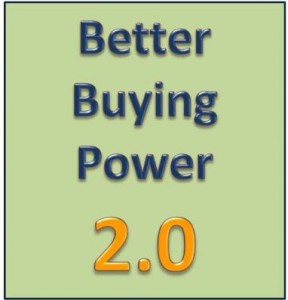 As we move further into an unprecedented era of tighter budgets and post war downsizing, it makes sense to implement Better Buying Power 2.0, the directive published by Frank Kendall, Undersecretary for Acquisition at the Department of Defense (DoD), in April 2013.
As we move further into an unprecedented era of tighter budgets and post war downsizing, it makes sense to implement Better Buying Power 2.0, the directive published by Frank Kendall, Undersecretary for Acquisition at the Department of Defense (DoD), in April 2013.
Bottom line – if you are a program under Acquisition Technology &Logistics (AT&L), you will want to implement as many BBP 2.0 elements as possible. Although required by DoD AT&L, BBP 2.0 contains tools to help any agency achieve its mission in delivering return on investment through effective and efficient acquisitions. For the most part, I believe agencies are following the guidance. I am going to comment on one agency and its progress.
First, a reminder of the top seven areas of BBP 2.0:
- Achieve Affordable Programs
- Control Costs Throughout the Product Lifecycle
- Incentivize Productivity & Innovation in Industry and Government
- Eliminate Unproductive Processes and Bureaucracy
- Promote Effective Competition
- Improve Tradecraft in Acquisition of Services
- Improve the Professionalism of the Total Acquisition Workforce
These seven areas of Mr. Kendall’s vision touch on nearly every aspect and element of an acquisition program with the goal to achieve greater efficiency and productivity in defense spending. Gone are the days when programs can run over budget and still survive. Program managers need to implement the following key ingredients to BBP 2.0, particularly if they are managing an Information Technology (IT) program.
What elements will and won’t work in an IT related program?
First and foremost in the guiding principles is the area of “critical thinking”. This concept is crucial to any successful program in that the acquisition work force should be applying their education, training, and experience as they implement BBP 2.0.
I support a major IT healthcare program charged with delivering IT related capabilities largely made up of commercial off the shelf (COTS) technology. Here are some ways I have seen BBP 2.0 considered and implemented within the IT healthcare program.
Specific sub areas under the seven 2.0 guidelines:
- Mandate “should cost” based management. – This element is primarily used with software design, development, and testing – this concept does not work with a COTS program in this context.
- Eliminate redundancy within the Warfighter portfolios – This concept is used within the program. There is extensive benefit analysis to obtain efficiencies when contracts are reviewed across the portfolio.
- Employ appropriate contract types – DoD guidance mandates this and within the IT business most direct purchase of goods are Firm Fixed Priced (FFP) and most service related contracts are some hybrid of Cost Plus and FFP.
- Better define value in “best value” competitions – in use now – most of the source selections utilize best value or “best value trade off” during the evaluation.
- Use open systems architecture – There is language included in all technical and production based requests for proposal.
- Consider Small Business – small business is highly sought after and market research considers small business for every solicitation going out of this agency. Each solicitation is sent through the small business advocate for consideration.
- Improve requirements definition/prevent requirements creep – This is a tough one to keep in check – especially with a dynamic multi-agency program.
- Expand the use of requirements review boards and tripwires – This is an area for improvement as the tripwires in place do not catch all of the areas required when analyzing requirements
Be efficient – the “acquisition culture” has changed or is changing (largely due to shrinking budgets) and is mindful of the cost consciousness requirement in the BBP 2.0. The current FY14 budget drills for this program all include trim – trim – trim!
Did I mention why BBP 2.0 is important to you?
In my blog on “Program Management in an Era of Tight Budgets” I talk about utilizing the concept of strategic sourcing, among other tips. BBP 2.0 is yet another tool to consider when forming your budgets. The current climate in Washington DC emphasizes operating with a tighter budget. BBP 2.0 provides some excellent guidance and policy, and guess what? These are very easy elements to aid in a successful program. Additionally, if you are a program operating under AT&L, leadership will expect you to conform to this policy.
If you remember anything from this blog when you execute your program – recall that the following four overarching principles apply to any program, IT or otherwise.
- Be a “thinking” acquisition workforce – BBP 2.0 is subject to professional judgment
- Empower your people – having a professional, experienced, trained and empowered workforce will lead to mission success
- Stick with the basics – apply the acquisition fundamentals because they work
- Streamline decisions – do not allow processes to consume the most precious resource – time
What have you experienced with respect to BBP 2.0 in your organizations?

